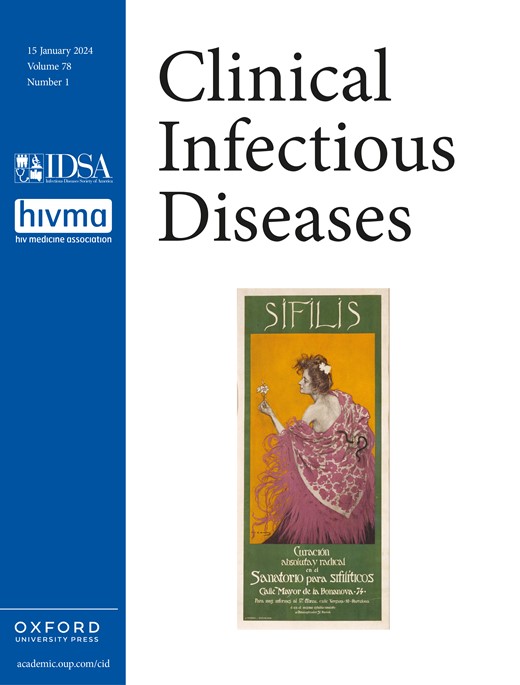注射吸毒者中的丙型肝炎病毒再治疗。
IF 8.2
1区 医学
Q1 IMMUNOLOGY
引用次数: 0
摘要
背景:在美国,丙型肝炎病毒(HCV)是导致感染性疾病死亡的主要原因。虽然高效的直接作用抗病毒(DAA)方案已经建立,但注射吸毒者(PWID)的再治疗尚未得到充分研究。本研究评估了DAA再治疗的结果和相关因素。方法:我们对HERO研究的纵向数据进行了分析,HERO研究是一项在美国8个州进行的多地点实用随机试验,旨在评估DAA treatment-naïve PWID在阿片类药物治疗方案和社区诊所中2种HCV护理模式的有效性。在初始HERO研究sofosbuvir/velpatasvir (SOF/VEL)治疗后,从2016年9月15日至2021年9月13日确定了符合再治疗条件的参与者。该分析的特点是参与者要么没有实现持续病毒学应答(SVR),要么在SVR后再次感染HCV。我们使用Fisher精确检验比较分类变量,使用Welch 2样本t检验和渐近2样本Mood中位数检验比较连续变量。结果104例患者符合再治疗条件。不到一半的43人(41.3%)开始了再治疗。在25例开始再治疗并获得SVR结果的患者中,24例达到SVR(96%)。未达到SVR的参与者比SVR后再感染的参与者更迅速地开始再治疗(分别为平均471天和784天,P < 0.001)。结论第一次DAA治疗方案再次感染或未达到SVR的PWID的SVR率高于首次DAA治疗方案。为了消除丙型肝炎病毒并使个人和公众健康受益,帮助PWID患者获得及时的再治疗至关重要。本文章由计算机程序翻译,如有差异,请以英文原文为准。
Retreatment of Hepatitis C Virus Among People Who Inject Drugs.
BACKGROUND
Hepatitis C virus (HCV) is a leading cause of infectious disease death in the United States. Although highly effective direct-acting antiviral (DAA) regimens are well established, retreatment among people who inject drugs (PWID) has not been sufficiently studied. This study assessed DAA retreatment outcomes and associated factors.
METHODS
We performed analyses of longitudinal data from the HERO Study, a US-based multi-site pragmatic randomized trial conducted in 8 states to evaluate effectiveness of 2 HCV care models among DAA treatment-naïve PWID in opioid treatment programs and community clinics. After initial HERO Study sofosbuvir/velpatasvir (SOF/VEL) treatment, participants eligible for retreatment were identified, from 15 September 2016 to 13 September 2021. This analysis characterizes participants who either did not achieve sustained virologic response (SVR) or were reinfected with HCV post-SVR. We compared categorical variables using Fisher exact test and continuous variables using the Welch 2 sample t test for means and an asymptotic 2-sample Mood median test.
RESULTS
One hundred four participants were identified as eligible for retreatment. Less than half, 43 (41.3%), initiated retreatment. Among the 25 who initiated retreatment and for whom SVR results were available, 24 achieved SVR (96%). Participants who did not achieve SVR initiated retreatment more promptly than participants reinfected post-SVR (respectively, 471 vs 784 days on average, P < .001).
CONCLUSIONS
After reinfection or not achieving SVR with the first DAA regimen, retreated PWID achieved higher SVR rates than with initial DAA treatment. To attain HCV elimination and benefit individual and public health, assisting PWID with accessing prompt retreatment is crucial.
求助全文
通过发布文献求助,成功后即可免费获取论文全文。
去求助
来源期刊

Clinical Infectious Diseases
医学-传染病学
CiteScore
25.00
自引率
2.50%
发文量
900
审稿时长
3 months
期刊介绍:
Clinical Infectious Diseases (CID) is dedicated to publishing original research, reviews, guidelines, and perspectives with the potential to reshape clinical practice, providing clinicians with valuable insights for patient care. CID comprehensively addresses the clinical presentation, diagnosis, treatment, and prevention of a wide spectrum of infectious diseases. The journal places a high priority on the assessment of current and innovative treatments, microbiology, immunology, and policies, ensuring relevance to patient care in its commitment to advancing the field of infectious diseases.
 求助内容:
求助内容: 应助结果提醒方式:
应助结果提醒方式:


